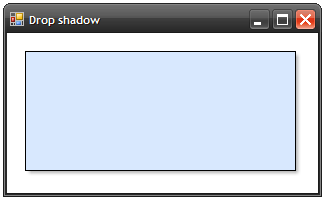
Introduction
For a project I'm working on, I had to create transparent fuzzy drop shadows similar to those found in various Windows applications. Want to have them too? Then read on! Or just download the sources...
Background
Unfortunately, there's no support at all for these drop shadows in Visual Studio 2005/WinForms, but there is in WPF! Fortunately, I only needed panels with shadows and shadows for rectangular shapes are easy. I just took the method I use for web pages and applied it to WinForms. The trick is as follows: Using strategically placed and tiled pictures of a shadow, we can simulate a shadow effect. When transparent PNGs are used, it looks just like the real thing. The image parts we need are outlined in red below:
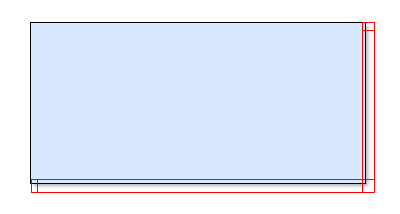
Normally, I'd start with creating these images. Luckily for you, I've already done it and have provided them with the source. Now it's time to start coding!
The project
Go to File > New > Project and select Class Library. Call it ShadowPanel and click OK. Now rename class1.cs to ShadowPanel.cs. That's the file we'll work with. It's always handy to create a test project. So, right click the solution in the solution explorer and select Add > New Project. Pick Windows Application this time and call it ShadowPanelTest.
Properties
First, we need some properties. It would be nice to provide at least a border and a background color. So, it's time to open ShadowPanel.cs and add the following:
using System;
using System.Text;
using System.Drawing;
using System.Drawing.Drawing2D;
using System.Windows.Forms;
namespace ShadowPanel
{
public class ShadowPanel : Panel
{
private Color _panelColor;
public Color PanelColor
{
get { return _panelColor; }
set { _panelColor = value; }
}
private Color _borderColor;
public Color BorderColor
{
get { return _borderColor; }
set { _borderColor = value; }
}
We can't use the original panel BackgroundColor property because that's for the entire panel, including the shadow area! So, I created a PanelColor property that defines the color for the area inside the shadow. About those references to System.Drawing and System.Drawing.Drawing2D: You might have to add them manually by right-clicking on References in the Solution Explorer and selecting them in the list.
Images
Now for the images that we can use to actually draw the shadow. You can download them with the sources if you didn't do this already. Create a folder in the project called Images and add the tshadowXXXX.png files. Select them in the solution explorer and change the Build Action to Embedded Resource. That way, the files will be compiled into the DLL and you won't need to distribute them with your application.
I added the images as static in the code; kudos go to Remco Schrijvers for proposing this. I also added two private members to describe the size of the images -- they are 5×5 pixel images -- and the offset (margin) of the shadow from the left and top. Please add the following code to the ShadowPanel class:
private int shadowSize = 5;
private int shadowMargin = 2;
static Image shadowDownRight =
new Bitmap(typeof(ShadowPanel), "Images.tshadowdownright.png");
static Image shadowDownLeft =
new Bitmap(typeof(ShadowPanel), "Images.tshadowdownleft.png");
static Image shadowDown =
new Bitmap(typeof(ShadowPanel), "Images.tshadowdown.png");
static Image shadowRight =
new Bitmap(typeof(ShadowPanel), "Images.tshadowright.png");
static Image shadowTopRight =
new Bitmap(typeof(ShadowPanel), "Images.tshadowtopright.png");
OnPaint()
Everything is now prepared for us to do the cool stuff: Creating GDI+ drawing code! Let's override the OnPaint method of the Panel base class.
protected override void OnPaint(PaintEventArgs e)
{
base.OnPaint(e);
Graphics g = e.Graphics;
First, we'll do the tiled images on the bottom and the right:
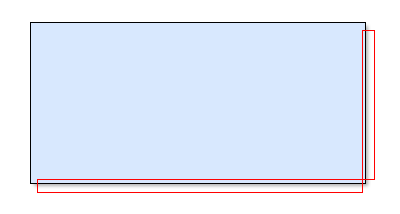
I think the code says it all. Just add the following after Graphics.g = e.Graphics;:
TextureBrush shadowRightBrush =
new TextureBrush(shadowRight, WrapMode.Tile);
TextureBrush shadowDownBrush =
new TextureBrush(shadowDown, WrapMode.Tile);
shadowDownBrush.TranslateTransform(0, Height - shadowSize);
shadowRightBrush.TranslateTransform(Width - shadowSize, 0);
Rectangle shadowDownRectangle = new Rectangle(
shadowSize + shadowMargin,
Height - shadowSize,
Width - (shadowSize * 2 + shadowMargin),
shadowSize
);
Rectangle shadowRightRectangle = new Rectangle(
Width - shadowSize,
shadowSize + shadowMargin,
shadowSize,
Height - (shadowSize * 2 + shadowMargin)
);
g.FillRectangle(shadowDownBrush, shadowDownRectangle);
g.FillRectangle(shadowRightBrush, shadowRightRectangle);
You can add ShadowPanel to the test project by opening the Form1.cs designer. If you build the project once, ShadowPanel should appear in the toolbox. Just drag it to the form and run it. You'll hopefully get the following result:
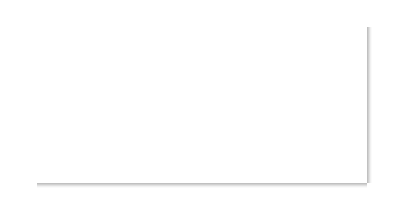
By the way: I set my form's background color to white, so it might look different for you.
Bring in the corners
To draw the small bitmaps in the corners, just add the following:
g.DrawImage(shadowTopRight, new Rectangle(Width - shadowSize,
shadowMargin, shadowSize, shadowSize));
g.DrawImage(shadowDownRight, new Rectangle(Width - shadowSize,
Height - shadowSize, shadowSize, shadowSize));
g.DrawImage(shadowDownLeft, new Rectangle(shadowMargin,
Height - shadowSize, shadowSize, shadowSize));
It's almost too easy.
Filling and bordering
We already have the PanelColor and BorderColor properties. Now it's time to put them to use.
Rectangle fullRectangle = new Rectangle(
1,
1,
Width - (shadowSize + 2),
Height - (shadowSize + 2)
);
if (PanelColor != null)
{
SolidBrush bgBrush = new SolidBrush(_panelColor);
g.FillRectangle(bgBrush, fullRectangle);
}
if (_borderColor != null)
{
Pen borderPen = new Pen(BorderColor);
g.DrawRectangle(borderPen, fullRectangle);
}
Time to check our results so far:
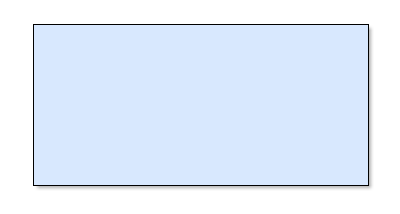
Well, that's about it. We're almost done.
Finishing up
As a formality, end the OnPaint method with:
shadowDownBrush.Dispose();
shadowRightBrush.Dispose();
shadowDownBrush = null;
shadowRightBrush = null;
}
To make sure the control repaints correctly when resized, we need to override the OnResize method. Thanks, BobishKindaGuy!
protected override void OnResize(EventArgs e)
{
base.Invalidate();
base.OnResize(e);
}
}
}
Done!
Points of interest
Of course, I won't stop you from adding more functionality. Please do! Also, let me know if you appreciated this tutorial!
History
- June 17th, 2007 - First version
- June 30th, 2007 - Added
OnResize
I'm a UI designer living in The Netherlands. Currently I'm using C# and Visual Studio 2005 with ASP.NET and Windows Forms.
I'm looking forward to working with WPF professionally (expression blend is just fantastic!)
 General
General  News
News  Suggestion
Suggestion  Question
Question  Bug
Bug  Answer
Answer  Joke
Joke  Praise
Praise  Rant
Rant  Admin
Admin 









